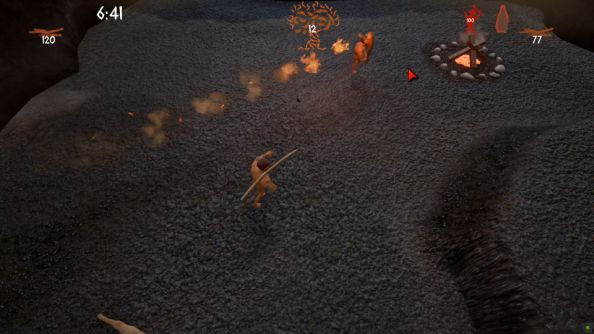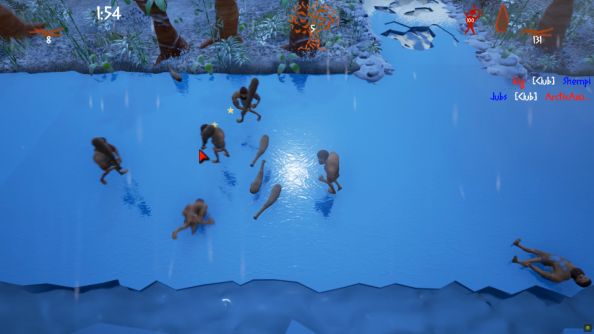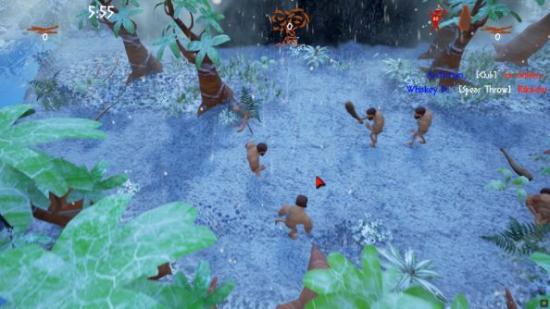Two tribes of cavemen are locked in a Promethean struggle for light and warmth. Lightning has fortuitously struck a nearby tree, and both sides swarm out of their caves to steal the flames and start a fire. Torches double as clubs and spears, and if these prehistoric players can’t fuel their own fire they’ll settle for smothering the enemy’s.
Like to dig into prehistory? Here are some really old games we quite like.
Yep: B.C.E. is a multiplayer game that redefines the term ‘firefight’.
“We fell in love with the idea because a game about cavemen smacking each other with clubs could be colourful, bizarre, and goofy,” says Arjun Rao of Boston’s Blue Drop Games.
It wasn’t always thus. The game began life as Kill Your Friends – interactive slasher cinema in which four victims attempted to escape a murderer. But as development got underway, two games appeared on Steam: first, four-versus-one horror affair Dead by Daylight. And second, an official Friday the 13th adaptation. The subgenre of asymmetrical multiplayer hunting games that had previously held just the one game – Evolve – was now chock-a with murderous alternatives.
Kill Your Friends had to change direction if it was going to stand out. The Blue Drop team were stumped. But then, in one dead-end design session, developer Conor Golden started “singing and babbling” Rusted Root’s gibberish acoustic guitar anthem, Send Me On My Way. The developers remembered its appearance in Hollywood’s Matilda, and then Ice Age, and voila: a prehistoric setting was born.
The footprint of Kill Your Friends is still visible. Quite literally – a conspicuous trail indicates where cavemen have recently trampled. But B.C.E. has an identity of its own, as an intriguing, isometric variant on Capture the Flag.
Winning is a numbers game: every three seconds, each team scores points proportional to the size of their fire. Any of the wooden weapons that players carry around can add to the flames – meaning that everybody’s running about with potential points.
“It puts direct responsibility of the score on all players, not just a sole flag carrier,” explains Rao. “One-flag CTF doesn’t encourage defense, so the gameplay is very linear. [B.C.E.] is more of a tug-of-war where attack and defense are played by both teams at different times throughout a single match.”

Further delicious complication is provided by the fact that thrown or dropped wood can be gathered by the opposing team. Every fight you lose contributes to the enemy’s stockpile – particularly if you were holding a flaming club or spear at the time of death.
Tactics have begun to emerge in testing: some teams carry bundles of wood back to their fire in bulk. Others designate a supporting gatherer to accompany attackers, resupplying them with weapons. And one particular aggressive macro strategy finds the entire team leaving their cave undefended, relying on map coverage to know they aren’t at risk of being attacked. A similarly effective counter-strategy, however, sees a single ‘back capper’ sneak behind enemy lines to extinguish the fire.
Close encounters can be tense, hesitant affairs, as each side feels out the other – stalling until help arrives or attempting to line up the perfect spear throw. Miss, and you might leave yourself open to a whack or a jab.
“We’ve found that even if you’re well-practiced in B.C.E.’s combat, 1v1 encounters can be very unpredictable,” says Rao. “We like that though. Multiplayer games are easier to design in a sense, because once you build a system of game mechanics for players to use, much of the fun emerges on its own.”

Not every element of B.C.E. has coalesced so naturally, of course. A tilted camera seemed like a great idea, until the team realised that players south of your screen could chuck spears at you completely unseen. That problem was eventually solved several months down the line via level design.
Rao says that Blueprint, Unreal Engine 4’s simplified scripting system, has allowed B.C.E. to come together quicker than it would have done otherwise: “I would have a hard time believing that anything can be faster than simplifying what would be large chunks of code down into simple nodes to use in visual scripting.”
With B.C.E. now Greenlit after just nine days on Steam, Blue Drop feel validated in the direction they’ve taken the onetime slasher simulator.
“Building a game that you yourself have designed is really stressful,” Rao admits. “Not because game development itself is very stressful but because it’s hard to see past the flaws. You spend hundreds of hours designing and implementing something with a big cloud of mystery surrounding it. Is this fun?
“I can’t even describe how good it feels when players pick up the game, know what they’re supposed to do, and have fun playing. It seems really obvious, but it’s hard to imagine a more rewarding feeling as a game designer.”
You can find B.C.E on Steam Greenlight. Unreal Engine 4 development is now free.
In this sponsored series, we’re looking at how game developers are taking advantage of Unreal Engine 4 to create a new generation of PC games. With thanks to Epic Games and Blue Drop Games.
